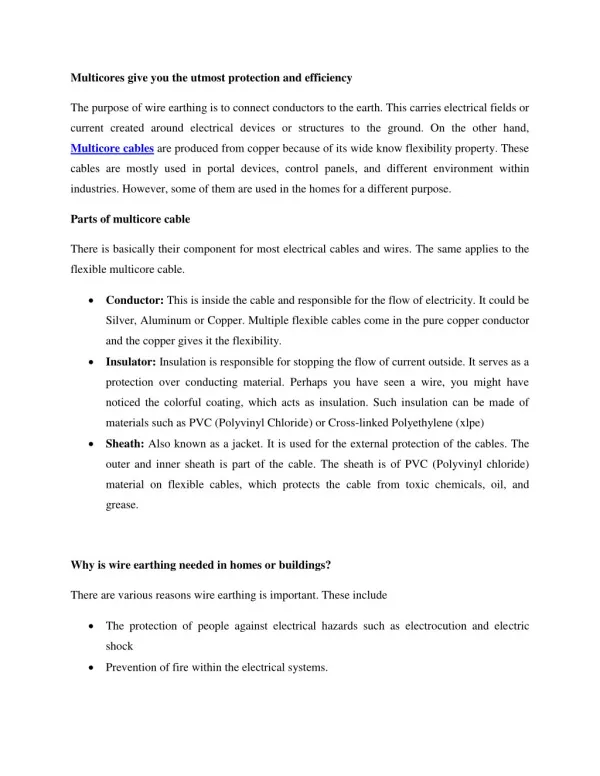Multicores give you the utmost protection and efficiency
The purpose of wire earthing is to connect conductors to the earth. This carries electrical fields or current created around electrical devices or structures to the ground. On the other hand, Multicore cables are produced from copper because of its wide know flexibility property. These cables are mostly used in portal devices, control panels, and different environment within industries. However, some of them are used in the homes for a different purpose. Parts of multicore cable There is basically their component for most electrical cables and wires. The same applies to the flexible multicore cable. • Conductor: This is inside the cable and responsible for the flow of electricity. It could be Silver, Aluminum or Copper. Multiple flexible cables come in the pure copper conductor and the copper gives it the flexibility. • Insulator: Insulation is responsible for stopping the flow of current outside. It serves as a protection over conducting material. Perhaps you have seen a wire, you might have noticed the colorful coating, which acts as insulation. Such insulation can be made of materials such as PVC (Polyvinyl Chloride) or Cross-linked Polyethylene (xlpe) • Sheath: Also known as a jacket. It is used for the external protection of the cables. The outer and inner sheath is part of the cable. The sheath is of PVC (Polyvinyl chloride) material on flexible cables, which protects the cable from toxic chemicals, oil, and grease. Why is wire earthing needed in homes or buildings? There are various reasons wire earthing is important. These include • The protection of people against electrical hazards such as electrocution and electric shock • Prevention of fire within the electrical systems. • Safeguarding electrical devices, machinery, power tools, and appliances from current leakage • Avoiding interference with communication circuits • Damage from lighting to structures installation. Earthing wire come in different types; however, the most popular methods used nowadays are: • Pipe Earthing: This is a galvanized steel perforated pipe inside the ground connected to the electrical conductors to the earth • Plate Earthing: This is a galvanized plate or copper plate buried in an earth bit beneath the ground level. The plate electrode connects the electrical conductors to the earth. • Chemical Earthing: This is similar to the pipe earthing discussed above. However, a chemical compound material replaces the salt layers and charcoal. • Rod Earthing: This is also similar to the pipe earthing but a copper rod replaces the pipe electrode. For most people, the choice of earthing method (rod, chemical, plate, and pipe) depends on various factors such as: • Cost consideration • Maintenance requirements • Possibility of overvoltage • Safety requirements for equipment and humans • Service continuity requirement at different voltages Materials, tools, and equipment needed for earthing • Wire mesh • Funnel • Bricks • Cement • PVC wires • Coke/charcoal and salt • Rod or pipe • Copper plate or GI • Copper wire or strip • Welding toolkit • Meggar for earth resistivity testing • Excavator for earth pit excavation The importance of proper grounding A property grounded circuit comprises of devices, boxes, and service panel grounds, which generate the electrical current the easiest path to ground while reducing the chances of someone being electrocuted or shock. Every household earthing or electrical systems must adhere to the National Electrical Code. The earth absorbs the short circuit or over current harmlessly and doing so, will eradicates the threat to anyone. However, ground wires, ground rods, devices, boxes, and service panels are not adequate. You shouldn’t forget to bond the grounds to the house’s copper waterlines. Author’s Bio Kelly Craig in this piece educates his readers on the importance of wire earthing. He further looked at multicore cables and the different method of wire earthing.
★
★
★
★
★
61 views • 3 slides


